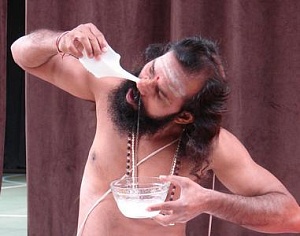News
-
 Pranayama workshop, Mar 1-7
Pranayama workshop, Mar 1-7
-
 21-day Pranayama challenge
21-day Pranayama challenge
-
 Nāda meditation workshop, January 8-12
Nāda meditation workshop, January 8-12
-
 April 3, Navaratri with Yogi Matsyendranath Maharaj, Australia, Queensland
April 3, Navaratri with Yogi Matsyendranath Maharaj, Australia, Queensland
-
 March 17, 2020. Purifiying Pranayama With Yogi Matsyendra Nath
March 17, 2020. Purifiying Pranayama With Yogi Matsyendra Nath
-
 November 2019, Tantra Workshop Series in Argentina
November 2019, Tantra Workshop Series in Argentina
-
 Workshop in Gualeguaychu
Workshop in Gualeguaychu
-
 17-18 November 2018, Yogi Matsyendranath in Źarate (Argentina)
17-18 November 2018, Yogi Matsyendranath in Źarate (Argentina)
-
 15-16 November 2018, Yogi Matsyendranath visit to Uruguay
15-16 November 2018, Yogi Matsyendranath visit to Uruguay
-
 12 Nov 2018, Lecture at USAL (Salvador University)
12 Nov 2018, Lecture at USAL (Salvador University)
-
 10-11 November 2018, Workshops in Quilmes and La Plata (Argentina)
10-11 November 2018, Workshops in Quilmes and La Plata (Argentina)
-
 8 November 2018, Open conference in Necochea (Argentina)
8 November 2018, Open conference in Necochea (Argentina)
-
 2,3,4 November 2018 - Participating in XVI Retreat International of Yoga and Meditation
2,3,4 November 2018 - Participating in XVI Retreat International of Yoga and Meditation
-
 Programme in Québec (Canada) 13-16 June
Programme in Québec (Canada) 13-16 June
-
 Melbourne Book Launch
Melbourne Book Launch
-
 4-years Summer Program
4-years Summer Program
-
 Biography of a Russian Yogi
Biography of a Russian Yogi
-
 November 2017, Visit of Yogi Matsyendranath to Argentina
November 2017, Visit of Yogi Matsyendranath to Argentina
-
 Satsangs of Yogi Matsyendranatha Maharaj in Berlin
Satsangs of Yogi Matsyendranatha Maharaj in Berlin
-
 Seminars and trainings in June-July 2015 (France)
Seminars and trainings in June-July 2015 (France)
Jala-neti
Jala-neti
 जल-नेती, jala-netī
जल-नेती, jala-netī
the nasopharynx purification with water
Jala-neti helps to remove excess mucus from the entire body, starting with the nostrils and sinuses, which often serve as a gate to keep mucus in the body. Using this method sets in motion the entire physical process to remove mucus, allowing air and energy to path throughout the circulatory and nervous systems, which in turn will positively affect digestion and other body systems. For a person suffering from excess mucus or phlegm accumulation, jala-neti is an important helper in improving health.
To perform jala-neti, it is necessary to have a special vessel for water – neti-pot.
The solution for jala-neti usually consists of warm water with a small amount of salt dissolved in it. Warm water is a sedative for mucous membranes. Although the water for jala-neti should be warm, but not hot, to avoid causing irritation. First you can check the water temperature with your finger, but it's worth remembering that the nasal mucosa is more sensitive than fingers.
Chlorine used in tap water can have an irritating effect. Therefore, many people prefer to use filtered or bottled water for neti-pot.
Cool water can also be used for neti-pot from time to time, especially during inflammation. Warmer water can be used to treat headaches or blockage of sinuses, as it is the best way to open sinuses, but this must be done carefully so as not to burn the mucous membranes.
Beginners should use water with a temperature slightly above room temp.
Performance technique:
Dissolve 10 grams of salt in one liter of warm water and pour it into a net-pot. Place the spout of the vessel in the right nostril, tilting your head to the side – so that the left nostril is lower. Open your mouth and breathe through it. Water will start pouring out of the left nostril.
Perform the same action with the other nostril.
If there is no sputum, neti can be performed without salt with cold water. Those who have a cough and a cold should perform neti only with warm salt water.
Neti cures colds and rhinorrhea.
Some people catch a cold while performing neti, so after neti you need to perform kapalabhati so that all the water comes out of the nose and the person does not catch a cold.

